This post will be on-going. I am going to introduce you to each AKC registered breed.
Sporting Dogs:
The Brittany Spaniel was named for the French province in which it originated, the Brittany was, from 1934 to 1982, registered by the American KennelClub as the spaniel, Brittany. Although until then called a spaniel, in its manner of working game the Brittany is setterlike. In appearance it is smaller than the setters but leggier than the spaniels, with a short tail and a characteristic high ear set. Effective September 1, 1982, its official AKC name was changed to Brittany.
While it is generally conceded that the basic stock for all bird dogs is the same, most of the actual facts concerning the development and spread of the various breeds are lost in antiquity. Early written records are confusing. Dogs are referred to as being of Bretagne or Brittania, which may have referred to the British Isles rather than the French province, for Brittany was called Armorique until the 5Th century. Oppian, who lived about 150 A.D., wrote of the uncivilized people of Brittany (or Britain?) and reported that their dogs' scenting ability surpassed all others, a characteristic many present-day Brittanys retain.
It would seem probable that the dogs of Brittany and Wales had the same progenitors and developed along similar paths, quite possibly interbreeding. The two lands are geographically close and there was much commerce between them. One need only look at today's Welsh Springer and Brittany to recognize their similar physical characteristics.
The first accurare records to pinpoint the actual Brittany-type dog are the paintings and tapestries of the 17Th century. The frequency with which this type appears suggest it was fairly common. Oudry (1686-1745) shows a liver and white dog pointing partridge and this same type of dog is common in the Flemish paintings of the school of Jan Steen. Other painter show this same type of dog, so it must have been common along the northern coast of France and in Holland, even stretching into Germany where it developed into the Wachtelhund, modern breed much like the Brittany in appearance and ability.
Legend has it that the first tailless ancestor of the modern Brittany was bred about the mid-1800s at Pontou, a little town situated in the Valley of Douron, the result of a cross between a white-and-mahogany bitch owned by an old hunter of the region, and a lemon-and-white dog brought to Brittany by an English sportsman for the woodcock shooting. Of two tailless specimens produced in this litter, only one was considered worth keeping. His work in the field has been described as wonderful because of it he became a popular stud. All his litters contained puppies either without tails or with short stubs.
There is nothing written before 1850 that can be interpreted unequivocally as referring to the Brittany. In that year the Reverend Davies wrote of hunting in Carhaix with small bob-tailed dogs not as smooth as the Pointer, that worked well in the brush. They pointed, retrieved their game well and were particularly popular with poachers, as the nature of that profession required that the dogs be easy to handle. The description fits the Brittany to perfection.
It was speculated (and in at least one case confirmed) that matings of the native spaniels of Brittany were made around 1900 with English pointing dogs whose owners vacationed in France primarily for the woodcock shooting. These matings were believed to have been effective in intensifying the pointing qualities of the spaniel while the basic features of the dogs remained essentially Breton.
The Brittany's became a recognized breed when, in 1907, Boy, and orange-and-white, was registered as the first l'epagneul Breton (queue courte naturelle), a nomenclature that was soon shortened to simply l'epagneul Breton. Prior to this date, Brittany's had competed in classes for miscellaneous French Spaniels.
The first standard was outlined in 1907. This early standard required that the tail always be short at birth and that, in order to discourage further cross-breedings, black-and-white dogs be disqualified. The requirement for the natural bob-tail was soon dropped.
The breed was introduced into the United States in 1931 and officially recognized by the American kennel Club in 1934. The first standard was a direct translation from the French and not particularly comprehensible. The first major accomplishment of the American Brittany Club upon its formation in 1942 was to replace the original standard with a clear and concise one.
The Brittany's steady gain in popularity in the United States has been due to its merits as a shooting dog. Its smaller size and natural proclivity for hunting close fill the need of the modern American bird hunter. Its superb nose and desire to please are tow of its major assets. Its size makes it better adapted to city living than some of the larger bird dogs, and its close range makes it more adaptable to today's hunting areas, crisscrossed with numerous roads and fences.
Many American Brittany breeders have strived to maintain the dual concept, i.e. to breed a dog that is good looking as well as being a good hunter. The most popular former competition has been in field trials, sponsored by the parent club and its many chapters. Interest in showing Brittany's was initially somewhat limited, but there has been an upsurge over recent years. In the first 30 years of competition in this country, over 150 dogs of the breed gained the coveted title of Dual Champion (a champion in both the field and show).
Official Standard for the Brittany:
General Appearance-compact, closely knit dog of medium size, a leggy dog having the appearance, as well as the agility, of a great ground coverer. Strong, vigorous, energetic and quick in movement. Ruggedness, without clumsiness, is a characteristic of the breed. He/she can be tailless, or has a tail docked to approximately 4(four) inches.
Size, Proportion, Substance of the Brittany:
Height - 17 1/2 to 20 1/2 inches, measured from the ground to the highest point of the shoulders. Any Brittany measuring under 17 1/2 inches or over 20 1/2 inches shall be disqualified from a dog show or competition.
Weight - Should weigh between 20 and 40 pounds.
Proportion - So leggy is he that his height at the shoulders is the same as the length of his body.
Body Length - Approximately the same as the height when measured at the shoulders. Body length is measured from the point of the forechest to the rear of the rump. A long body should be heavily penalized.
Substance - Not too light in bone, yet never heavyboned or cumbersome.
Head:
Expression - Alert and eager, but with the soft expression of a bird dog.
Eyes - Well set in head. Well protected from briars by a heavy, expressive eyebrow. A prominent, full or popeye should be heavily penalized. It is a serious fault in a dog that must face briars. Skull well chiseled under the eyes, so that the lower lid is not pulled back to form a pocket or haw that would catch seeds, dirt and weed dust. Preferences should be for the darker colored eyes, though lighter shades of amber should not be penalized. Light and mean-looking eyes should be heavily penalized.
Ears - Set high, above the level of the eyes. Short or triangular, rather than pendulous, reaching about half the length of the muzzle. Should lie flat and close to the head, with the tip rounded very slightly. Ears well covered with dense, but relatively short hair, and with little fringe.
Skull - Medium length, rounded, very slightly wedge-shaped, but evenly made. Width not quite as wide as the length, and never so broad as to appear coarse, or so narrow as to appear racy. Well defined, but gently sloping stop. Median line rather indistinct. The occiput only apparent to the touch. Lateral walls well rounded. The Brittany should never be "appleheaded" and he should never have an indented stop.
Kallee and Tamara

A Beautiful Summer Day.
Madam Kallee, CTD, CGC - 1994-2005 - Certified Therapy Dog and a Canine Good Citizen
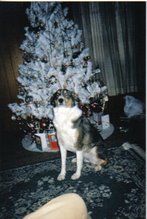
I am so pretty!
Kallee, T.D.I., CGC - Certified Therapy Dog and a Canine Good Citizen - 1994-2005

I loved to pose for the camera.
Hat Girl.

The things I do for my mom!
Happiness.

Bubby knows how to scratch a tummy.
Best of Friends.

Mine! No, Mine!, No Mine!!!
Whew !

Bubby wears me out!
This is the Life.

Just relaxing with bubby.
Kallee and Mr. Monkey
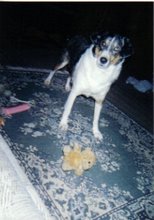
See Mr. Monkey? Wanna play?
Miss Cool.
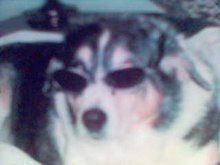
I loved to wear my shades.
Sunday, June 17, 2007
Subscribe to:
Post Comments (Atom)
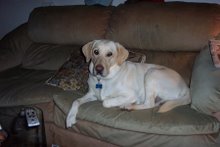

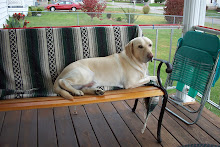
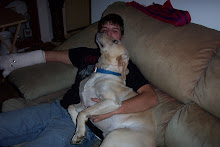
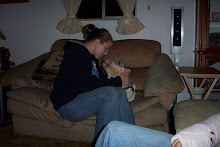
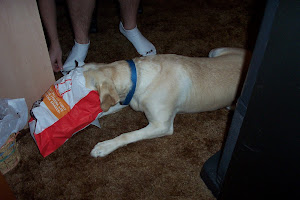
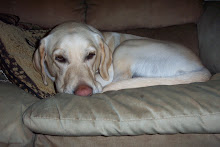

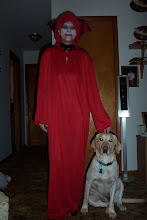
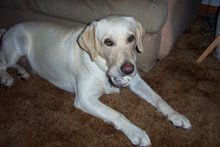
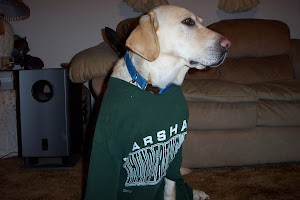


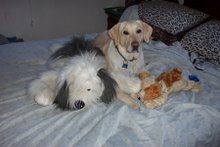

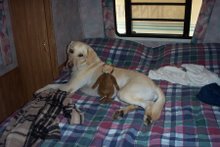
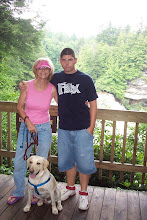
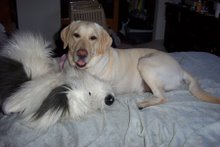
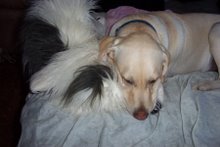
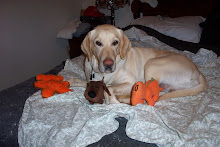
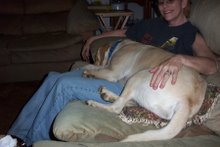
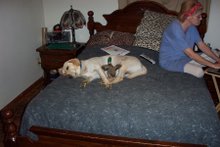
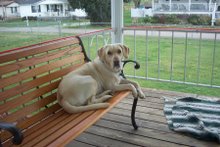
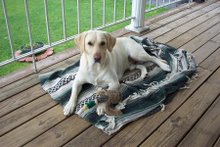
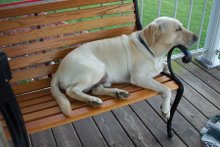

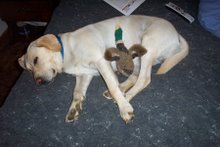
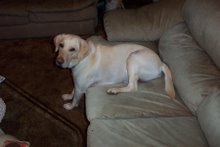
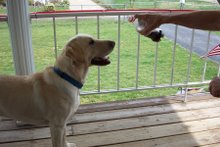
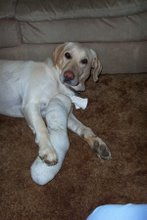

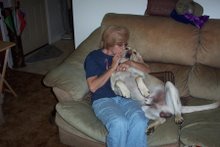
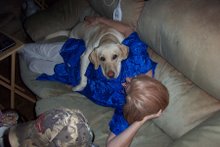
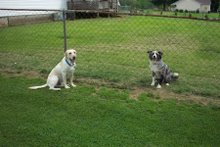
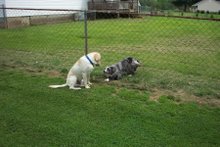
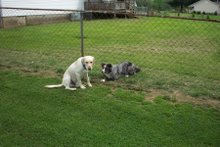
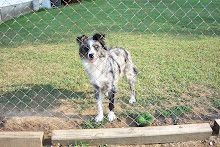
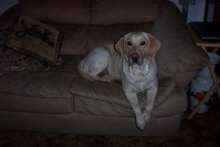
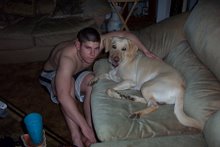
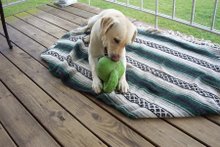
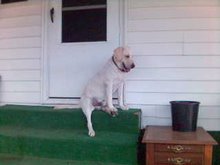




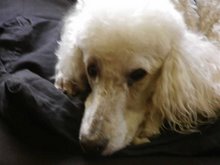

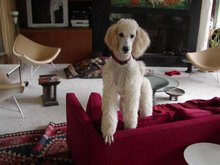
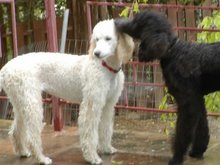
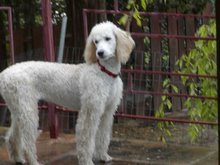

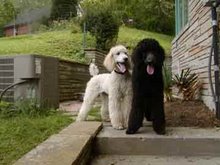
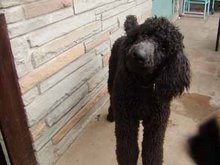
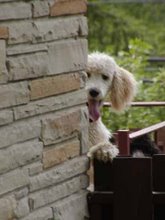
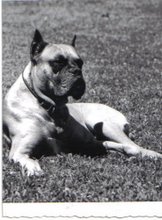

No comments:
Post a Comment